To learn more, visit https://kriss-usa.com/.
To purchase on GunsAmerica.com, click this link: https://www.gunsamerica.com/Search.aspx?T=vector%2010mm.
When it comes to firearms, there are many reasons to choose various kinds of guns related to the intended purpose of the tool. There are hunting guns, concealed carry guns, home defense guns, duty guns, competition guns, and collectible guns – just to name half a dozen. But when it comes to the pistol caliber carbine (PCC) those lines and reasons can become blurred, and the obvious use of the gun can be less obvious. Why one might want the size and weight of a long gun with the ballistic properties of a handgun is a topic worthy of the kind of debate that ends with the bartender saying, “You don’t have to go home, but you can’t stay here”.

The flat top of the Vector has 13″ of Picatinny rail and includes the Magpul flip-sights. The author had ample room to mount his Aimpoint PRO.
The KRISS Vector revolutionized the PCC concept with the release of the first model, chambered in .45 ACP. A carbine in .45 ACP wasn’t very revolutionary – even Bonnie and Clyde had one of those – but what was revolutionary was the operating design of the Vector. KRISS created the “Super V” system that sends the bolt slightly rearward and then sharply downward during recoil. This bolt movement is accompanied by an inertia block and it sends significant recoil energy downward, rather than directly back to the shooter. The theory is that this not only reduces the felt recoil impulse, but also nearly eliminates muzzle lift. KRISS followed the .45 caliber with the offering of 9mm, as part of the Gen II redesign.
All the while, I was admiring the KRISS Vector from afar, being curious and appreciative of its design but never having an opportunity to shoot one, or feeling overly compelled to acquire it. Back to the argument about why to own a PCC, for me it has always been considered a range toy with some prospect for home defense. Most handgun ammunition is engineered to optimize its performance in handguns, and most handguns have barrels less than five inches. While a rifle length barrel can and does usually increase velocity a little bit, it is usually not significant enough to alter the effectiveness of the round. There are some exceptions, however, and the one that always comes to mind for me is the 10mm round. Properly loaded, the 10mm leaves a pile of unrealized performance on the table when fired from a handgun, even one with a six inch barrel. But put that same powerhouse cartridge through a 16-inch barrel that allows for full burn and optimized gas push, and you might be talking about a real increase in performance. At the same time, the weight and operating properties of a carbine absorb much of the energy of a hot round. And finally, the Super V system of the Vector sending that energy downward and not back into the shooter – makes this the perfect marriage of carbine and pistol caliber. The announcement that KRISS was going to offer the Vector in 10mm got me out of my chair. Now I’m more than just interested! I have to try this one!
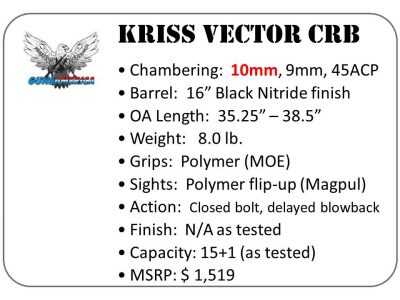 THE SPECS
THE SPECS
The Vector is available in several configurations: the SBR (short 5 ½-inch barrel rifle); the SDP (pistol with arm brace); and the one being looked at here, the CRB (carbine with 16-inch barrel). Oh wait, I forgot to mention the SMG… which is the submachine gun variant. Available only to military and law enforcement – darn it. While I agree that there is a place for the SBR in a pistol caliber, I prefer the full-length barrel. Arguably the SBR is a more maneuverable tool for home defense, but with a 5.5-inch barrel I don’t see any advantage over a Glock 40. But speaking of the Glock 10mm handgun – the standard G20/G40 magazine is the feeding device used in the KRISS Vector. While it would be nice to have a 30-round magazine available, I take my solace in knowing that I can always get the G20 mags at good prices with immediate delivery. And if the sales of the 10mm Vector are healthy, I’m sure KRISS will eventually offer an extension, as they do for the .45 ACP.
The 16-inch barrel on the CRB is not a replaceable/changeable part – at least not for the unskilled. The carbine consists essentially of the original 5.5-inch barrel with a permanently attached extension to 16 inches. Enthusiasts who like to tinker and transform their rifles might find this objectionable. And while the faux-suppressor looking barrel shroud can be removed, the barrel is not threaded – making your suppressor options “faux or no”. If these two issues are insurmountable for you, then the SBR version is for you. I prefer the ballistic performance, so I’m okay with it.
The action is operated by delayed blowback, and the bolt pushes an inertia block downward just behind the shooter’s support hand and then a recoil spring returns it up and forward, stripping and feeding the next round and locking the bolt into battery. This placement of the action just behind the magazine and shooter’s support hand theoretically optimizes the balance and stability there and helps reduce the recoil impulse further. I do try to avoid the over-use of adjectives, clichés, and buzzwords – but this does qualify as a revolutionary innovation. But it hasn’t been without its trials and tribulations. The first generation Vectors were reported to have numerous malfunction consistencies and many considered the gun to be little more than an expensive conversation piece. Good manufacturers pay attention to what’s going on in the field and listen to their customers and detractors, and make changes. KRISS did just that, and made a number of design changes for the Gen II Vector. Those changes include deleting the flashlight port out front, adding some optional Cerakote finishes, redesigning the pistol grip and buttstock to Magpul furniture, some redesign of the trigger and safety, etc. Far more than a simple cosmetic makeover.
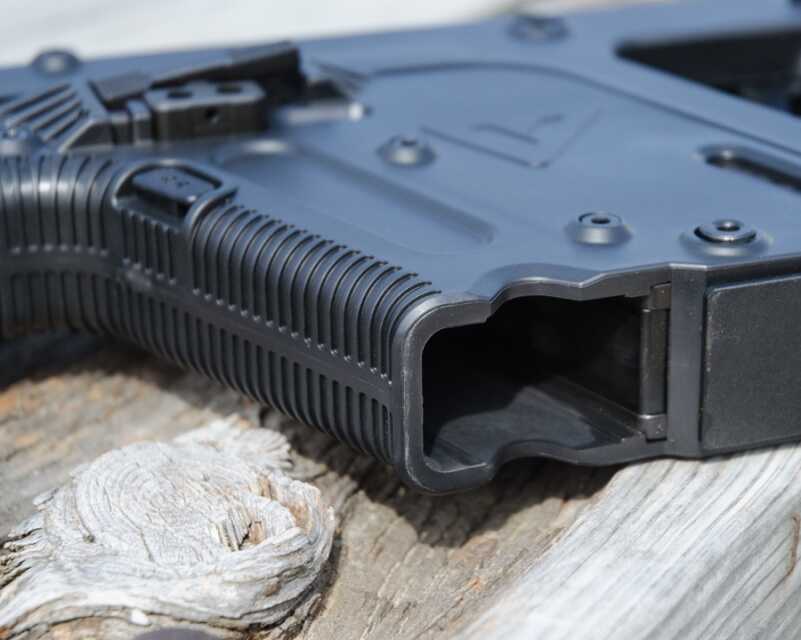
Located just in front of the action, the magazine well takes standard Glock mags and is nicely textured for grip.
ERGONOMICS AND FURNITURE
The ergonomics of the KRISS Vector Gen II are certainly different from the ubiquitous AR platform. But as true as that is, and as different as the design is, the carbine is remarkably intuitive to shoot and operate.
The KRISS Vector might look a bit like a duck-billed platypus, but the feel of the gun and the placement of the controls is generally intuitive and comfortable. As noted, the furniture is primarily Magpul polymer components, specially made for the Vector. The signature appearance of the pistol grip is probably enough to make that connection, but if you turn the carbine upside down and see the “MOE” stamp on the cover of the grip story area, all doubts are gone. The collapsible M4 style stock has six positions. It sits on a mil-spec tube that is fastened with a traditional castle nut. The stock is good quality and has a nice rubber butt pad. But if you prefer the Gen I folding stock, you can buy one and swap it out – they are compatible. In fact, the right side of the lower receiver still has the catch to latch the folding stock to. One important thing absent from the stock, for me, is some padding. I’ll go into why in a bit, when I talk about shooting the Vector.

A questionable choice was making the ejection port out of plastic. You can already see wear from ejected cases. KRISS even warns in the manual that when field stripped the hammer could break it if the trigger is pulled.
The unique design of the Vector also provides a natural grip area for the support hand. In fact, there are really two – one vertical and one horizontal. The front of the magazine housing is nicely textured for grip and is large enough and wide enough that it makes a comfortable hold point for people with nearly any size paw. Just in front of that, the grip curves into a horizontal section of Picatinny rail. If you opt to leave that rail empty, it offers a nice second hold point. You can also attach a vertical grip here, as many do. One of the most common complaints about the Vector is that the bolt-hold lever can be accidentally depressed by the shooter’s grip and inadvertently cause a stoppage by locking the bolt back prematurely. I experienced this for myself a few times, and became mindful of where I was placing my hand. I have small to medium sized hands, so I can imagine this is a more serious issue with bigger folks. Making me wonder why KRISS doesn’t just put a vertical grip on the Vector right off the bat. They even show one being used in their own marketing photos! Was it a big problem for me? No. But I can understand how it might be for some.
This brings me to the next frequently heard complaint about the controls placement on the KRISS carbines – the magazine release. It seems to be a common concern that the forward grip hand is going to depress the magazine release button and unintentionally drop the magazine. The placement of the control certainly makes that a legitimate concern, but no matter how hard I squeezed or at what angle I placed my forward hand, I could not make that happen. Your mileage may vary, but I’m calling that a non-issue. But in terms of using the mag release for its intended purpose, it is one of the best. It has just the right amount of resistance without being too stiff, and the button is large and serrated. Using the left thumb to press in the button and then sweeping the hand downward to strip out the empty magazine is effective and very efficient.

This illustration, taken from the KRISS website, shows the unique design of the action. Image courtesy of KRISS.
The fire control group on the KRISS Vector is somewhat of an oddity, or at least a departure from the conventional. The trigger is part of the upper receiver and is located above the bore axis. The hammer swings down like a pendulum to strike the firing pin. Think of it this way – a traditional hammer swings like… well, like a hammer! The pivot is at the bottom and the striking force is at the top. The Vector is the reverse of this, like a croquet mallet – with the pivot at the top and the striking force at the bottom. Mechanically there is no difference… it’s just not what we’re used to. The trigger itself is a decent one. The shape and length of the trigger are helpful in easily finding that sweet spot. The trigger is more flat than most, helping to give the stroke a more linear feel. It breaks at a pretty crisp 6 lbs. and the reset is decently short and very tactile. If I were going to consistently shoot groups with this ‘rifle’, I would want some tuning done to lighten it and take out some of the creep, but for a PCC and its applicable uses I find it sufficient.
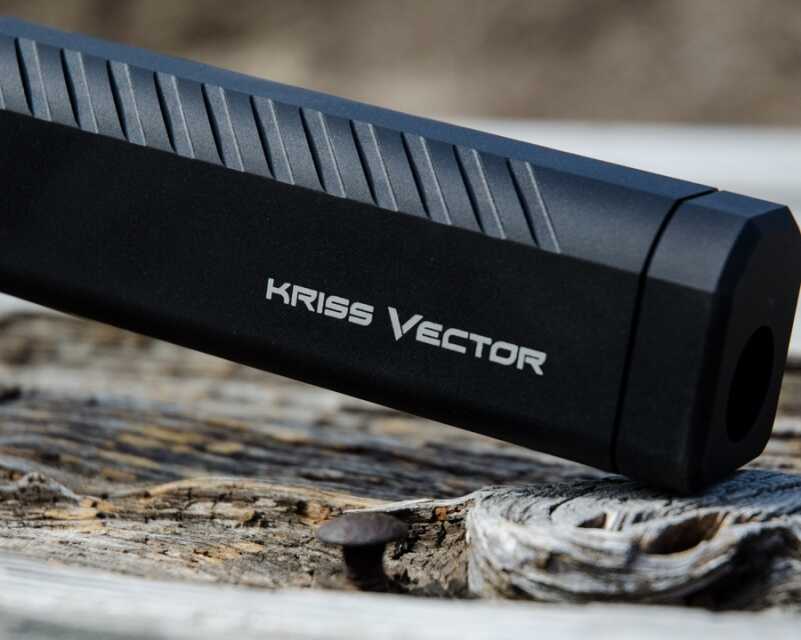
The barrel shroud is designed to improve the looks of the Vector. While it might resemble a suppressor, it is not one.
The Vector has an ambidextrous safety. One of the changes from Gen I to Gen II was to shorten the required stroke of the safety, which now requires only about a ¼ throw. I find the location of the lever somewhat awkward. It seems like it needs to be either lower or further forward… or something. I often used my trigger finger to manipulate it rather than my thumb. The charging handle and bolt catch are paired together on the carbine very nicely, and work together exceptionally well. The charging handle folds close to the body of the gun when not in use, and the operator pulls it briskly to the rear to draw back the bolt, and then releases it to allow the internal spring to push the bolt forward, strip a round from the magazine, and lock the bolt in battery. However, if you are using the charging handle to clear the firearm or to lock the bolt open, you can simply press in on the bolt catch when you reach the rear of the charging stroke. It is intuitive and simple to do, unlike the contortions I find myself in trying to lock the bolt open on many semi-auto rifles. To release the bolt, you simply press the other end of this see-saw type lever. Easy peasy.
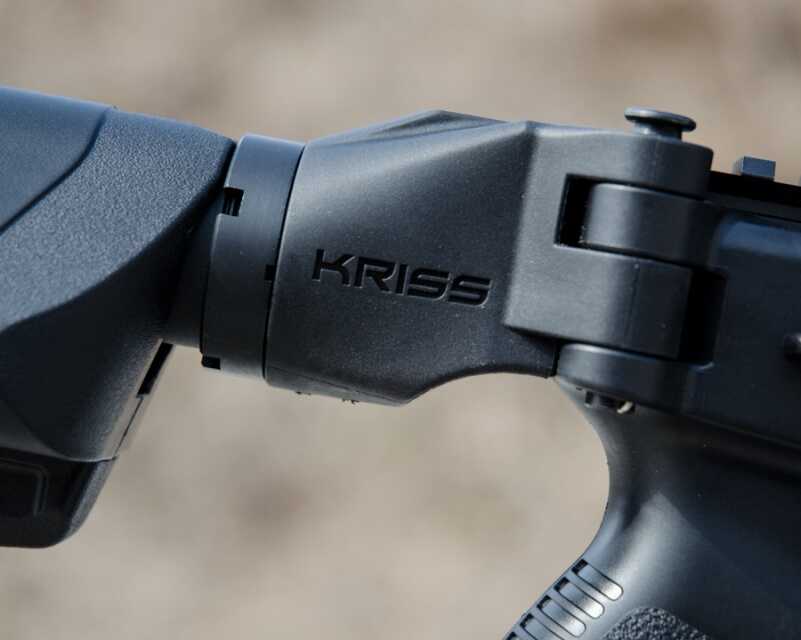
The Gen II stock does not fold, but can easily be replaced with the original folding stock, via a single pin.
SHOOTING THE VECTOR
Until I received my copy of the KRISS Vector and started range work for this review, I had never touched one before, so this was truly a first for me. This gives me the advantage of putting words down after a fresh and somewhat different experience – and the experience of shooting the Vector, at least in 10mm, is different. Let’s start with recoil. If you read the industry hype and marketing material, it will have you believing that you can’t tell the KRISS from an Airsoft replica recoil wise, due to the “V-Power” action design. As already described, this system sends significant energy downward rather than straight back into the shooter’s shoulder. And that is true. But that does not mean there is no recoil, or that it is insignificant. Again, we’re talking 10mm here. I’m sure the 9mm version is an entirely different experience. After just a few magazines I became aware of something that I was not used to – pain in my cheek. In fact, by the end of the first day of shooting, my right cheek was so sore that it hurt without touching it.
Being the curious type, and knowing I would have to describe this to you, I have a theory. Ever since the first person shouldered a gunpowder fired weapon (back in ancient China presumably), that connection of long gun to shoulder has been the common pivot point. When the gun recoils, the energy is pushed straight back (mostly, because things like grip and the shape of the gun come into play) into the shooter’s contact point. The shooter becomes a barrier to that motion, which then pushes the energy upward and gives us the muzzle lift we are all used to.
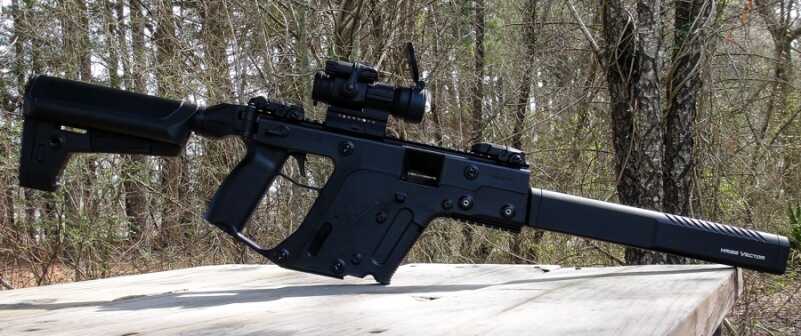
Note that the trigger is slightly above the bore. This puts the shooter’s grip much higher than a conventional rifle or carbine.
The Vector sends a majority of that energy downward at a steep angle to help reduce muzzle lift. And it works. But the laws of physics are not repealed and all that energy must dissipate. What brings the bolt back into battery is a recoil spring that sends it up and forward with sufficient force. That energy lifts the gun back upward and slightly forward. So, what you have is an almost rocking motion (that can be plainly seen in slow motion video) that sends the butt of the gun not straight back, but downward and then sharply upward. It is literally smacking you in the face with every shot. I tried holding tighter, altering my position, everything I could think of. I immediately did an Internet search for a pad to place on the top of the stock. At least for the 10mm version of this carbine, KRISS should install one as standard equipment. I found that raising the scope by using a spacer did help by giving me a much better position on the stock. It also gave me much better eye relief. The Vector’s flat top sits very low.
Other than the part about going 3 rounds with Mike Tyson every time you take the Vector to the range, it shoots like a dream. The Super V system really does work as advertised in keeping the muzzle lift under control, and even with the potent 10mm round, follow up shots in quick succession are easy and stay right on target. The trigger, while certainly not match grade, is very good and is easy to control properly. The flip-up Magpul sights that sit on the 13” of Picatinny up top give you a nice sight picture and were close to zero out of the box. Aside from the tendency to sometimes interfere with the bolt catch by placement of the support hand, the controls are perfect and top quality. There were no malfunctions of any kind with over 400 rounds down range.
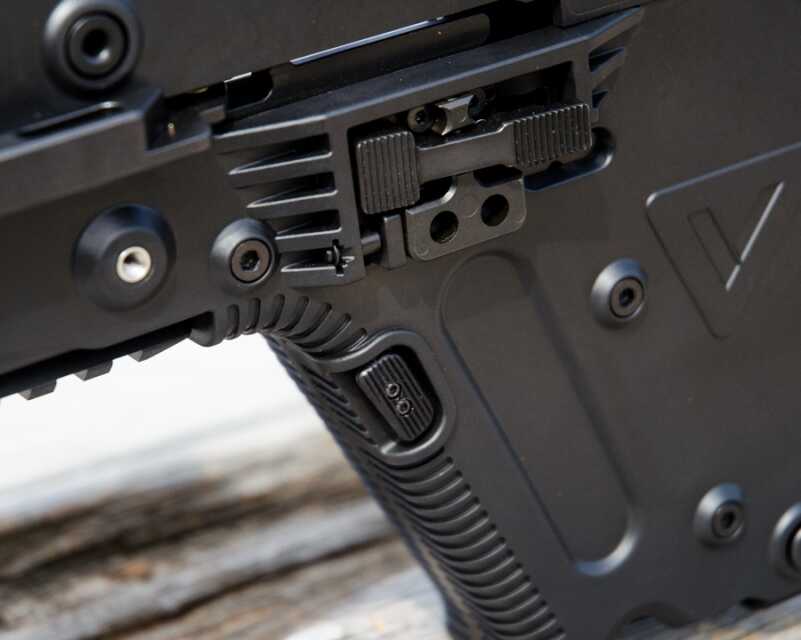
The forward grip area is convenient and comfortable, but many users find that their support hand interferes with the magazine release and bolt catch.
The 10mm round is one of the most inherently accurate pistol calibers. It is also, in this writer’s opinion, one of the few pistol calibers that can truly benefit from the carbine. First, let’s look at the accuracy of the Vector with an assortment of ammo. At 25 yards doing sight-in work, I was able to refine the combination of the Vector and the Burris AR-5.56 scope to printing consistent all-holes-touching groups. Moving out to 50 yards, things opened up considerably but still made respectable groups with most ammo, the best being the LAX 180 grain and the SIG Sauer Elite Performance 180 grain – both jacketed flat points. Just for fun, I moved to the 100 yard range but with low expectations. Those expectations were right on the money – because at the century mark using the LAX ammo, the hits were literally all over the target. The good news is that none of them missed paper. My tests are certainly not conclusive or anywhere near exhaustive, but I would recommend this PCC for inside 50 yard use – which is pretty much what most PCC’s are intended for. I achieved essentially the same group size results with the Aimpoint PRO mounted at 50 yards as I did with the Burris, further strengthening my opinion that it is ideal for close quarters to medium range.

The six-position buttstock is good quality and standard M4 compatible. Note the traditional castle nut attachment.
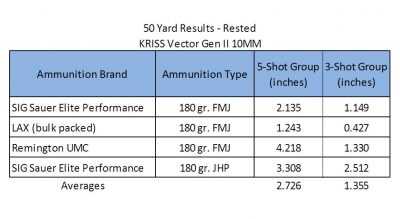 I mentioned that the 10mm round is one that can benefit from the added length of a pistol caliber carbine. There are a few schools of thought on stretching the barrel for handgun ammo: First, that the extra barrel will create more friction and thereby slow the velocity of the round; second, that the added burn time behind the projectile will increase the velocity significantly; and third, some folks don’t think it matters either way. My opinion on this, based part on observations and part on my own sense of logic, is that most handgun ammunition is loaded to optimize its performance in a handgun. A 4” to 6” barrel is most common and likely the range the ammo is developed to unless it’s a boutique load. Why? Because the big ammo makers want their ammo to perform well in the guns that are going to shoot 99% of it, and they also don’t want to see money flying out of the end of your barrel in the way of unburned powder or big fire balls. So, adding length to the barrel for 9mm may not pay huge dividends, but for a hot round like the 10mm it can. To prove this, I tested the LAX ammo – first through the Glock 40 with a 6” barrel, and then through the KRISS Vector with its 16” barrel. I intended to test several ammo types, but due to a mishap that stopped that work, I wasn’t able to. Watch the companion video review for that. From the Glock, the LAX produced 1128 fps average velocity (5 shots at a distance of 12 feet). The same ammo yielded an average of 1327 fps when fired from the KRISS. That’s roughly 18% more velocity and that is nothing to sneeze at. It should be noted that the number for the Vector was only the average of two shots. If you want to see a bonehead gun writer shoot his own chronograph… watch the video.
I mentioned that the 10mm round is one that can benefit from the added length of a pistol caliber carbine. There are a few schools of thought on stretching the barrel for handgun ammo: First, that the extra barrel will create more friction and thereby slow the velocity of the round; second, that the added burn time behind the projectile will increase the velocity significantly; and third, some folks don’t think it matters either way. My opinion on this, based part on observations and part on my own sense of logic, is that most handgun ammunition is loaded to optimize its performance in a handgun. A 4” to 6” barrel is most common and likely the range the ammo is developed to unless it’s a boutique load. Why? Because the big ammo makers want their ammo to perform well in the guns that are going to shoot 99% of it, and they also don’t want to see money flying out of the end of your barrel in the way of unburned powder or big fire balls. So, adding length to the barrel for 9mm may not pay huge dividends, but for a hot round like the 10mm it can. To prove this, I tested the LAX ammo – first through the Glock 40 with a 6” barrel, and then through the KRISS Vector with its 16” barrel. I intended to test several ammo types, but due to a mishap that stopped that work, I wasn’t able to. Watch the companion video review for that. From the Glock, the LAX produced 1128 fps average velocity (5 shots at a distance of 12 feet). The same ammo yielded an average of 1327 fps when fired from the KRISS. That’s roughly 18% more velocity and that is nothing to sneeze at. It should be noted that the number for the Vector was only the average of two shots. If you want to see a bonehead gun writer shoot his own chronograph… watch the video.
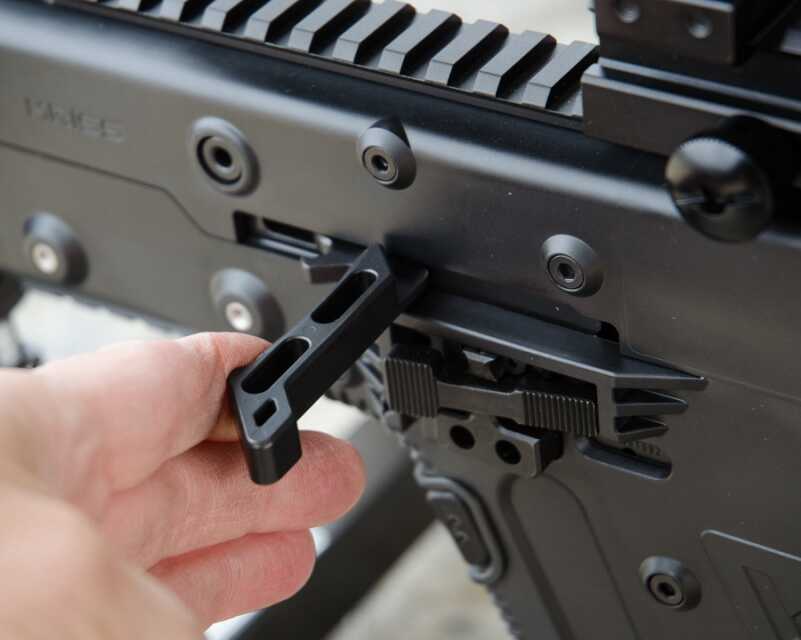
The charging handle is sturdy and well located. Operation is simple and allows the shooter to easily lock the bolt open.
JUST MY OPINION
I am a fan of the pistol caliber carbine for a number of reasons, not the least of which is that they are great fun at the range, and make viable home defense weapons. What has interested me about the KRISS from the onset was the unique approach to its design and the willingness to innovate. Some of the early concerns for reliability have been well addressed with the Gen II, as well as improvements to the ergonomics. In 10mm, the recoil of the carbine is not unlike an AR-15 in snap, but the Vector system makes it more a bounce than a push straight back. This took some getting used to while I got a sore cheekbone from it. But after some adjustments to the equipment and my technique that improved. The KRISS Vector sits at the high end of the price range for a PCC, and that may deter many would-be adopters in the civilian market.
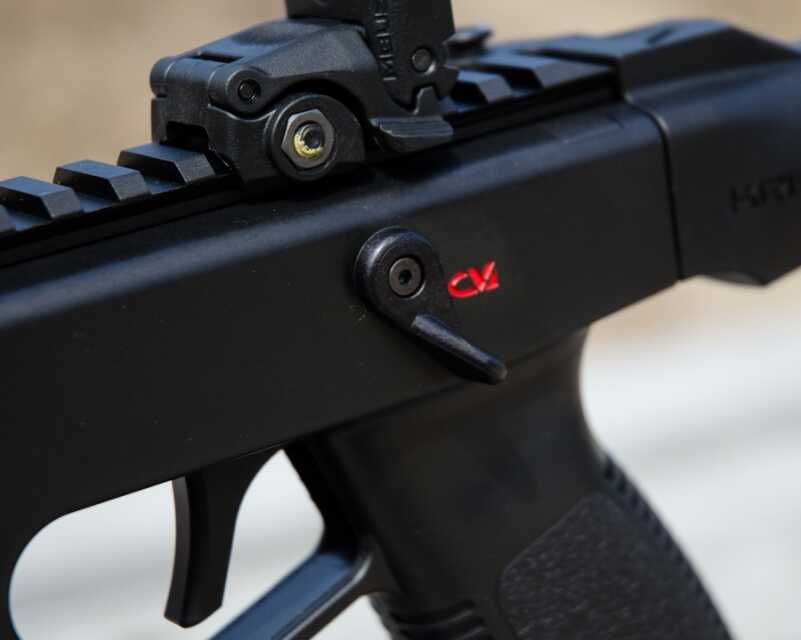
A big change for the Gen II was to significantly shorten the stroke of the manual safety from 120 degrees to just 45.
I find the gun to be mostly out-of-the-box ready, but I will be adding a vertical grip immediately to avoid some of the areas where controls and my grip are competing for real estate. I think it would be a smart addition for KRISS to put one in the box. The use of Glock magazines seals the deal, making them plentiful, affordable, and reliable. In this respect, the lack of innovation is to be applauded.
For me, the Vector excels with a good red dot sight on it and an expected use of less than 50 yards. Inside that circle, this would be a defensive option that is hard to beat, especially with some hot JHP loads. The gun ran everything I fed it with no stoppages or malfunctions of any kind. For 9mm, I think there are better options that weigh less and cost less, but in .45 ACP and especially in 10mm the KRISS Vector Gen II has set the bar.
To learn more, visit https://kriss-usa.com/.
To purchase on GunsAmerica.com, click this link: https://www.gunsamerica.com/Search.aspx?T=vector%2010mm.

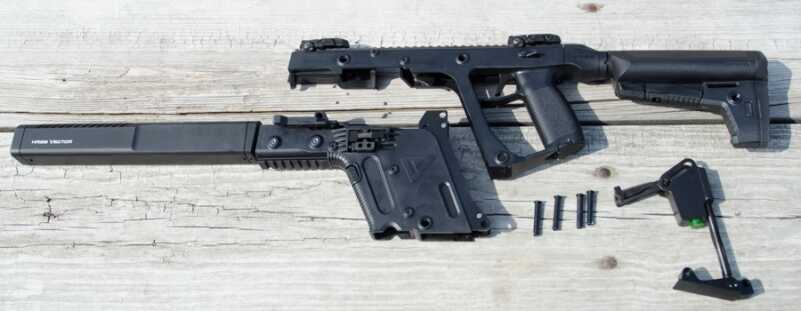
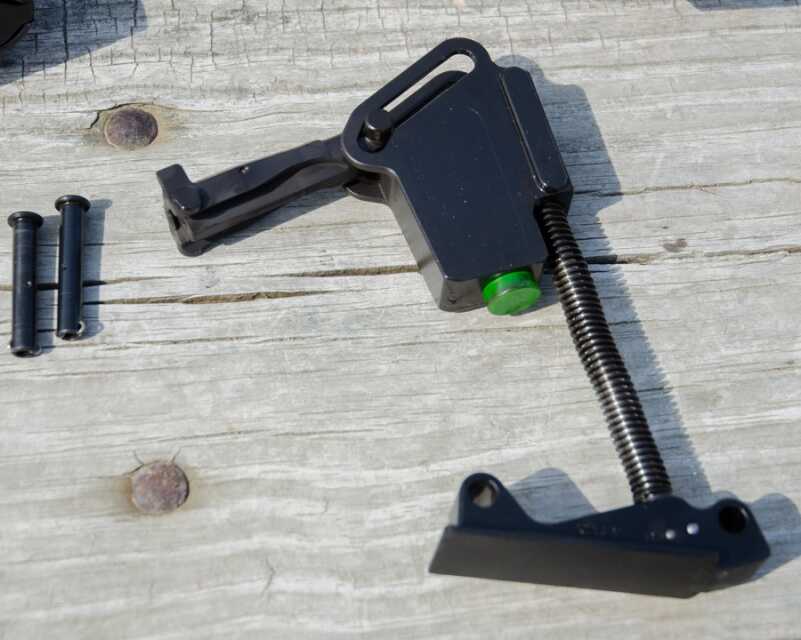
These things are ridiculous! Ever shoot one? It’s an over complicated fix to a non problem. If you can’t learn to shoot a .45 or a 10mm and properly control the recoil then there’s a 9mm out there for ya. Or a .380 or a .22 or…… If you need more power get yourself a AR platform carbine in a small rifle caliber… I get the idea of trying to create a market for a new product but dangit man these things are stupid expensive and way over engineered…
10mm was the basis of Col. Jeff Cooper’s “Thumper” SMG/carbine concept from the early 1980s. Heckler & Koch also had the same idea, and made their MP5 carbine available in 10mm and .40 S&W, but stopped making those variants owing to durability problems). The newer H&K UMP is available in .40 S&W but not 10mm.
It’ll be interesting to see how well the Kriss action holds up to the recoil and chamber pressure of 10mm. It could be strong enough. We’ll see.
I have a 10mm Kriss pistol with the brace. I have fired 200 rounds through this firearm. I have been a fan of the 10mm since it’s conception. I have large hands and the right side safety lever ate all the skin off the top of my hand. I also had issues with engagement of the slide stop with my left hand when using a 2 handed hold. The brace is difficult to use and aim effectively one handed. I intend to modify the safety and slide stop by trimming them and am looking into having the stock hinge installed to allow more ease in 1 handed operation.I have fired the pistol using bulk 180 gr FMJFP I purchased from Cabelas I believe and had no issue hitting metal popper plates out to 75 yards with open sights. To my taste this is a great pistol.
***
What does this very expensive pistol round carbine have over the traditional and more powerful .30 Cal. M-1 Carbine folding stock paratrooper version? Looks like a solution to a problem that was solved 7 decades ago! Good out to 200 yards, and with the excellent Hornady FTX ammo–real expansion. Almost zero recoil, and 5.5 pound weight. New from Fulton Armory for around $1000 bucks. With Picatinny rail and adjustable sights also.
***
John Bibb
***
While I like a 357 Mag carbine, the M1 is a reasonable choice also.
I have a gen2 45acp and 9mm all have issues with ftf and fte. Seems like having too clean after 200 rounds or so too keep functioning properly. Forget the delayed blowback and stick too a di or maybe a piston type. At 100 yards sits a silhouette that I can 3 and 5 tap even with west Texas winds all hits. From last trigger pull I can hear all 3 or 5 shots hits just with standard loads. If I sell my 9 and/or 45acp I would buy a 10mm or a 357sig (16 inch barrel).
I have a gen 1 Kriss Vector 45 acp. I like the feel of the gun, but the trigger is awful. What is worse is that Kriss voids your warranty if you even try to disassemble the gun’s trigger assembly. Here comes the gen 2, so i call Kriss every few months to see when they would offer the retrofit (they promised they would offer due to the overwhelming amount of people complaining about the gen 1’s ). They kept saying they they are working on it and that it would be available on their website in a month or two. So i kept calling every 3 months, and I kept getting the same run around . A couple of years later ,I finally gave up. They never offered it that i am aware of. The gen 1 is really hard to shoot well due to the terrible trigger, but being an SBR and ordered sight unseen , I did not have the option of trying it before I bought ($1800 ouch!) , I would not do it again. I would not buy a gen 2 either. The combination of lack of support, and the fact that they are still not great triggers is enough for me to just look else where. They look cool at the range, but that’s about it ….
I think the 460 Rowland would also be a good caliber for this firearm design.
Pistol cartridge in a carbine usually is a good thing due to efficient use of powder, specifically kinetic energy per grain of powder. For example, 30-06 or 270 yield around 50 fp KE per grain of powder from a 22″ barrel. 45 lc or 357 mag loads out of a 16″ carbine, 80 or more fp KE per grain. Next time someone talks about or spills gun writer ink a out a cartridge’s efficiency, just do the arithmetic, you will often be surprised at what is really efficient.
That said, in my opinion, this is an ugly and poorly executed firearm. Get a 357 lever gun & stoke it with 180 gr loads, you are ready for most game and any social use.
I own a Kriss pistol in 45ACP. I went with it for a suppressor that I am waiting on the ATF for since 230 grain does the job, is subsonic and the 10mm was not available at the time. It is a good time and Kriss extensions and Asian magazines are readily available for it. The Asian mags are my preference due to price. The Kriss extension can be modified for the Glock 20 mag. I have one for another brand of pistol caliber carbine. Shooting a chronograph would be extremely easy with a Vector due to the relatively high sight plane and low bore axis. Close shots with my pistol print very low, but at longer distances it shoots to point of aim as the sight plane and bore axis converge. It is nice to see data on 10mm shot through a longer barrel. It would be interesting to see what some Underwood or Doubletap that has the higher velocity would do through the longer barrel.
Someone start making the .44automags again
Let’s see the kriss in that chambering
I’ve been saying since the beginning.